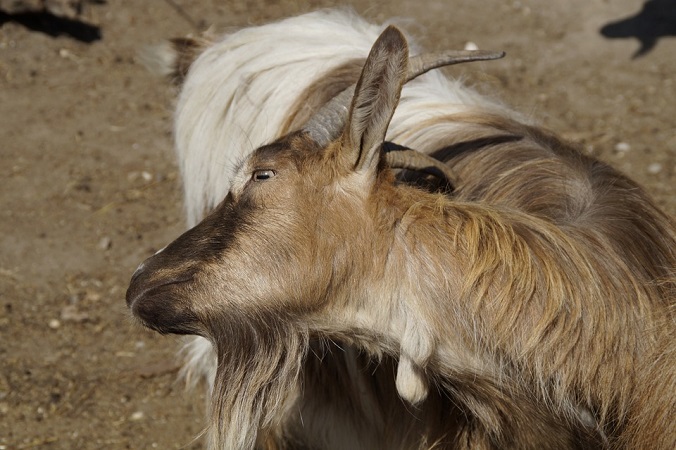

If your goats are biting and scratching, suspect lice. The easiest place to spot goat lice is just behind the foreleg, directly on the skin. Goat lice are very common in cold months, and finding them does not mean you are a bad herdsman. If you don’t see them, it doesn’t mean they are not there.
Goats are susceptible to many parasitic conditions worms, mites, and lice because parasites are part of the environment. It may be next to impossible to eliminate parasites, but with good management practices, we can mitigate their effects on herd health. Cold climates and the associated confined areas are ideal conditions for lice infestation.
If the thought or sight of goat lice makes your skin crawl, rest assured: lice are species specific. Goat lice only infest goats. You may get one on you, but you will not get them, nor will your house, or your dog. Lice are spread by contact from goat to goat and cannot live long apart from a goat. They only reproduce on goats. It is possible to have mechanical transmission, meaning a louse or nit (a lice egg) is transferred from one goat to another from a collar, blanket, or other object. In heavy infestations, some producers may strip their barns suspecting the presence of lice or nits in the goat bedding. While it is possible to transfer goat lice through bedding, it isn’t necessary to strip your goat shelter, as the treatment protocol addresses the full life cycle on the goat, including any lice that may attach from goat bedding during the course of treatment.
Knowing when your goat has lice
Lice may initially look like dirt under the hair against the skin, but if you watch for a moment, they move. They are very similar to fleas. You might also notice eggs or nits attached to the hair follicles. Sometimes nits are the only indication of an infestation.
There are two types of goat lice: biting and sucking. Unlike mites, lice are visible without the use of a microscope. Since biting lice feed on hair and skin, they have a wider head to accommodate a chewing apparatus. This wider head may not be apparent without a microscope or magnifying glass, but their bodies tend to be lighter in color, ranging from grey to tan. Sucking lice have narrow heads and pierce the skin to feed on blood. As a result, their blood-filled bodies appear darker, and there is often evidence on the goat’s skin. Goats infested with lice will have dull coats, excessive biting, scratching, rubbing, and grooming behavior, and may have patches of missing or thinning hair as a result. Goats infested with sucking lice may also have scabby, bleeding areas that can develop bacterial infections if not treated.
Treating goat lice
There are two types of chemical treatments for goat lice: topical and systemic. Treatment depends on the type of lice present. Biting lice can be controlled with a topical treatment (a liquid or powder applied directly to the skin) while sucking lice may be controlled topically but usually require a systemic treatment (oral or injected).
Almost all treatments used to control goat lice are “off-label,” meaning that the medication is not specifically labelled or approved for goats, nor is a dosage given on the package. For that reason, we cannot recommend treatment. A veterinarian must be consulted to advise on the off-label use of medication. You may also find an experienced herdsman or goat mentor who can share their parasite management practices with you. As with all medication, care must be taken for dairy and meat animals to respect withdrawal times and not harvest meat or milk while the medicine is still present in the system. For pregnant and very young animals, some medications may not be safe to use.
Because of the drug-resistance of parasites in goats, is important to use a chemical targeted at the specific parasite. While a chemical dewormer may be effective, if the lice can be eliminated topically by using an insecticide, it is preferable.
Brushing and using a nit comb can be helpful in reducing the severity of the infestation, but may not be effective in eliminating the lice.
When treating goats for lice, it is imperative to consider the 30-day life cycle of the parasite. Lice hatch, reproduce, lay eggs (nits), and die. The nits hatch somewhere between nine and 12 days. For this reason, two treatments are required, ideally two weeks apart, to eliminate the active lice and then eliminate the lice that hatch from the nits before they are able to mature and deposit more nits.
There are herd management practices that can reduce the severity and frequency of infestation. Many producers apply insecticides to their herds in late fall preventatively, before a full infestation occurs. Strong, healthy goats on high-energy diets tend to be less susceptible to parasites.
Stressed animals are always the first to be compromised. Since lice are spread by contact, minimizing overcrowding can reduce the transmission from goat to goat. When introducing new goats to a herd, use strict quarantine protocol. Test, evaluate, assess, and treat any new animals for a minimum of 30 days before introducing them to a herd.
 Contact Jaguza Support
Contact Jaguza Support